 |
| Figure 1. A pharaoh ant queen and her workers. Photo credits: Luigi Pontieri [1] |
Table of Contents
The pharaoh ant, Monomorium pharaonis (Linnaeus, 1758), is a member of the ants (Formicidae) family. Despite its namesake, the pharaoh ant did not originate from Egypt. Its spread has been so extensive that even scientists are confused as to where the species originated from! Various scientists have claimed that the pharaoh ant is native to Africa [2,3]. However, this has been refuted by other scientists, such as Wetterer (2010) who had looked through both published and unpublished specimen records. He asserted that the pharaoh ant is native to tropical Asia, where it has been frequently sighted across the continent, especially outdoors [4]. The geographic origin of the species hence remains in contention.
Having been dispersed worldwide via human commerce, the pharaoh ant currently occupies all major biogeographic regions. It can be found practically everywhere and has been recorded from Singapore as early as 1858 [5]! The species is currently notorious globally as a household pest species despite being only approximately 2 mm. Read on to find out more about this ubiquitous tiny ant that has been associated with the mighty Egyptian pharaohs!
 |
| Figure 2. Pharaoh ant. Image credits: Adapted from various sources [6,7,8] |
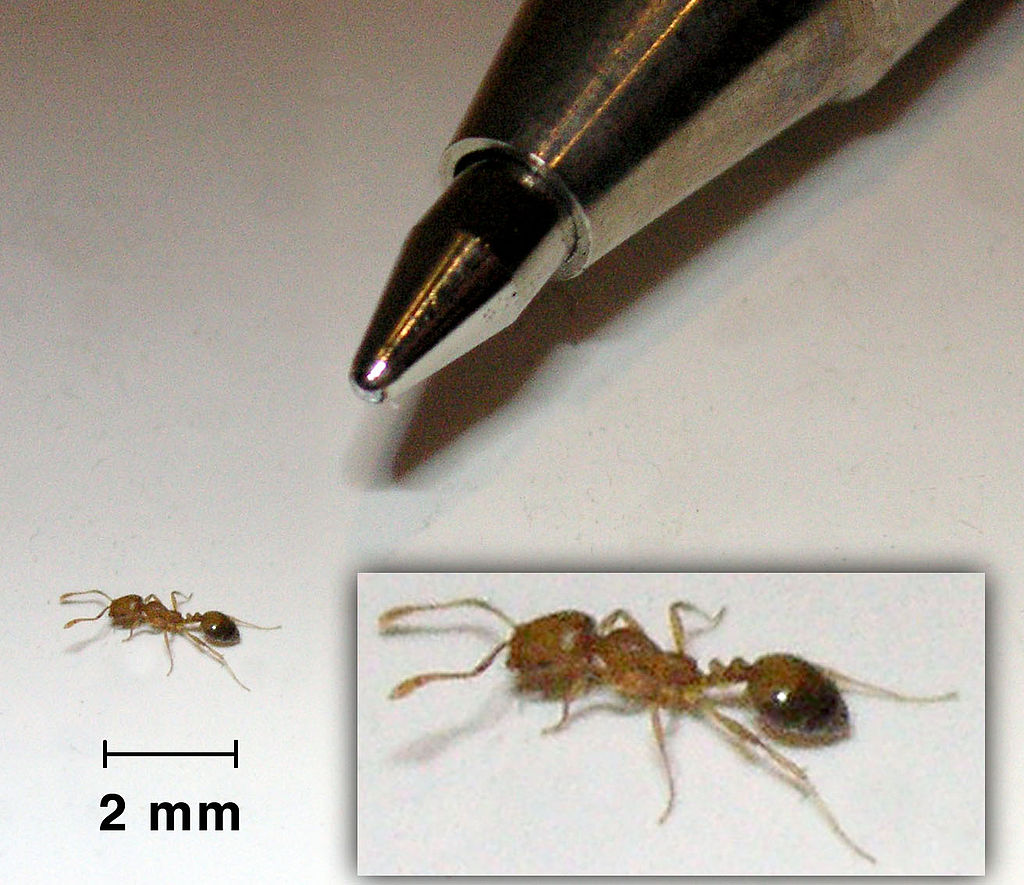 |
| Figure 3. The tiny size of the pharaoh ant is evident from compared to a pen tip. Photo credits: Wikipedia Commons [9] |
1. Habitat
Monomorium pharaonis lives in a huge diversity of habitats, including deserts, grasslands, mountains, forests, agricultural plantations and urban areas [10]. Pharaoh ants are commonly found nesting in cracks and under floorings of houses [11]. The species is typically restricted to tropical or subtropical climates [12]. Yet, buildings with internal heating in temperate climates have allowed the pharaoh ant to invade into the temperate zone and nest in such buildings [13]. However due to the cold climates, it has rarely been observed outdoors. Additionally, M. pharaonis prefers to nest indoors (wall crevices, potted plants, electrical sockets etc) [14,15].
 |
| Figure 4. Various habitats that Monomorium pharaonis lives in. Image credits: Adapted from various sources [16,17,18,19,20] |
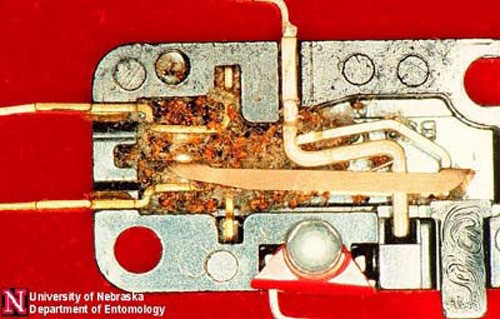 |
| Figure 5. Pharaoh ants found in an electrical socket. Photo credits: Jim Kalisch [22] |
2. Geographical Distribution
Considered the most common house ant in the world, the pharaoh ant is everywhere! The species currently occupies all major biogeographic regions. Since more than a century ago, its ubiquity has already been acknowledged by entomologists. In 1906, German entomologist, Hugo Viehmeyer, said of Monomorium pharaonis: "Coming from the East Indies, this ant has conquered almost the entire Earth. It has spread through commerce into almost all larger cities." [23] In 1967, Wilson & Taylor wrote, “This little species is probably the most widely distributed of all ant species.” [24] Distributed worldwide through human commerce, it can be found everywhere except at the north and south poles (Fig. 6). Due to its reliance on human-mediated dispersal and close human associations (e.g. nesting within human structures), M. pharaonis is considered a tramp ant (invasive ant) species [25].
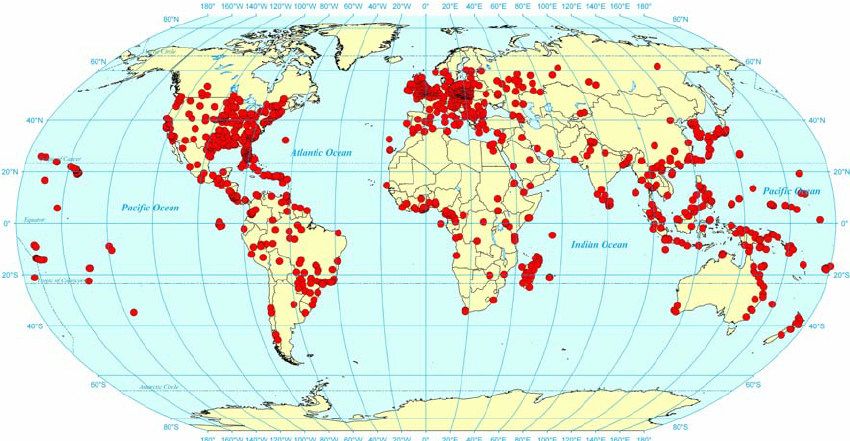 |
| Figure 6. Worldwide distribution records of Monomorium pharaonis. Image credits: Wetterer J. K. [26] |
3. Identification
Monomorium pharaonis consists of three castes – male alate, queen and female worker. Each caste has its own distinct morphology: male alates are black, queens are the largest among the three castes and workers are simply brown and tiny.
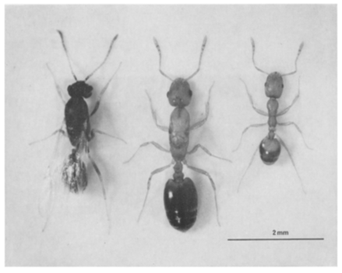 |
| Figure 7. The 3 castes of pharaoh ants: male alate (left), queen (centre) and worker (right). Photo credits: Edwards J. P. & Baker L. F. [27] |
3.1. Worker
Pharaoh worker ants are really small (2.2 – 2.4 mm) [5]! They are uniformly yellow-brown, with some having dark brown coloration at the end of their gasters [5,28]. Sparse hairs cover their bodies. Under the naked eye, they may look like any other ant species. However, it is a different picture when viewed under the microscope. Did you know that insects can have two types of eyes, simple and compound? Simple eyes are known as ocelli, while compound eyes are made up of multiple units called ommatidia. Pharaoh ants have no ocelli, but they have a pair of small black oval compound eyes. Each compound eye has approximately 20 to 25 ommatidia [29]. Ants have a pair of “hands”, known as mandibles used to bite/cut and hold food. Each mandible has 4 to 5 teeth, with the terminal tooth long and curved [29]. Ants also have a pair of antennae which they use to follow scent trails and communicate with each other [30]. Each antenna of the pharaoh ant is geniculate (bent at a sharp angle) and comprises of 12 segments [31]. The club-like tip of the antenna is made up of 3 segments.
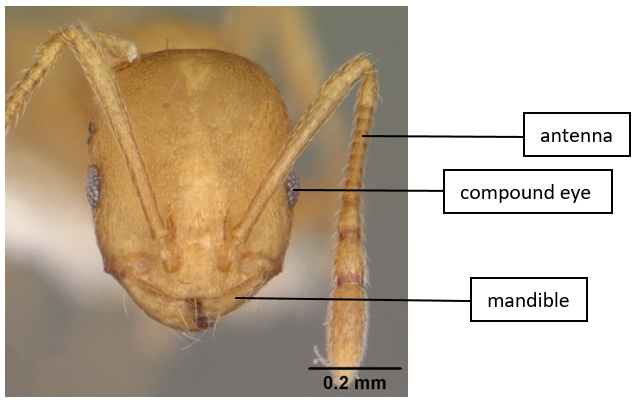 |
| Figure 8. Head of a worker pharaoh ant. Photo credits: April Nobile [32] |
Unlike other ant species like Tetramorium sp. that has two pairs of spines at the top of its thorax’s rear, the pharaoh ant does not have any spines at all [31]. It has a segmented pedicel that includes the petiole and post-petiole. Its gaster is oval and 4-segmented [28]. Although the tiny pharaoh worker ant may appear harmless, it actually has a sting at the end of its gaster [31]. Commonly mistaken with Trichomyrmex destructor due to similar morphology, one main difference is that the body surface of T. destructor is shiny while that of M. pharaonis is dull [12]. (Fun fact: Did you know that Trichomyrmex destructor is also known as the Singapore ant?!)
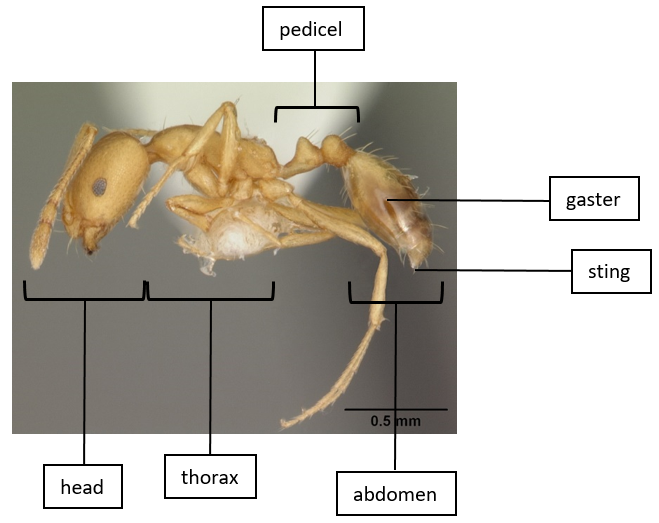 |
| Figure 9. Body of a worker pharaoh ant. Photo credits: April Nobile [33] |
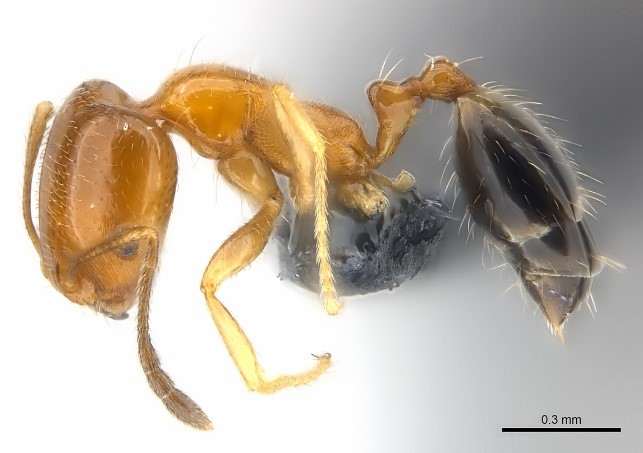 |
| Figure 10. Specimen of Trichomyrmex destructor. Photo credits: Erin Prado [34] |
3.2. Female alate/Queen
Being 4.3 mm long, pharaoh ant queens are larger than their workers [28]. They are a dull yellow-brown, with three-quarters of their gasters dark brown [29]. They have a pair of large black round-oval compound eyes, each having approximately 200 ommatidia (10 times that of a worker) [28,29]! Additionally, each queen ant has 3 ocelli, which is absent in worker ants [29]. They have mandibles similar to the workers, each mandible having 4 to 5 teeth [29]. The main difference between pharaoh ant queens and their workers is their possession of wings (alate). After a few days however, the queens will sever off their wings and become dealated (no wings) [28]. In this case, they can be differentiated from workers by their larger overall size and larger gasters [28].
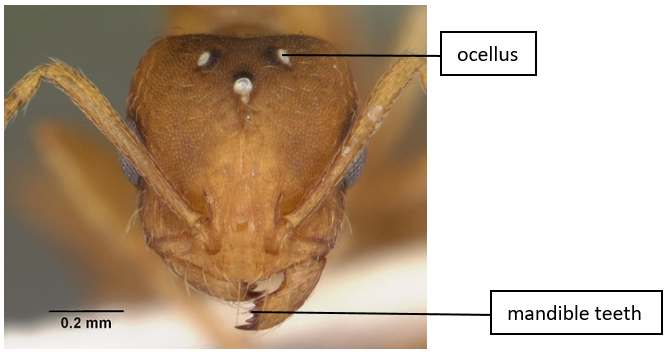 |
| Figure 11. Head of a queen pharaoh ant. Photo credits: April Nobile [35] |
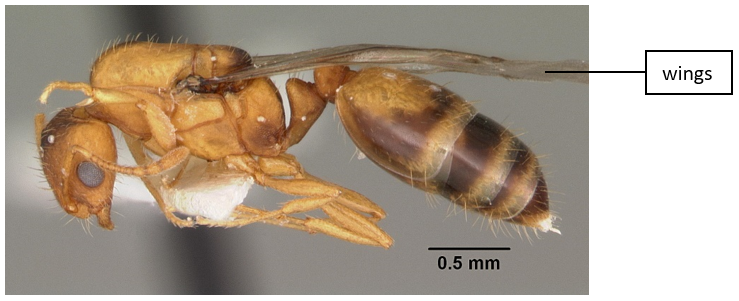 |
| Figure 12. Body of a queen pharaoh ant. Photo credits: April Nobile [36] |
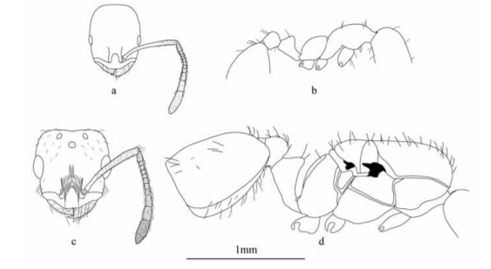 |
| Figure 13. Difference in the head and body of a worker and queen pharaoh ant. Image credits: Biologiezentrum Linz [37] |
3.3. Male alate
The male alates are 3.0 mm, of intermediate size between the queens and the workers [38]. Unlike the other two castes that are yellow-brown, male alates are black with straw-coloured antennae and legs [38]. Their eyes are black and round, compared to the oval eyes of the workers. Additionally, the eyes are very large, made up of approximately 450 ommatidia [28]! Similar to the queens, the male alates also have 3 ocelli. Their mandibles have 3 teeth, with the terminal tooth long and curved [28]. They also possess wings just like the queens.
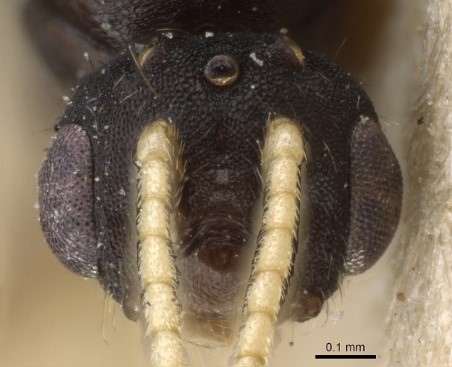 |
| Figure 14. Head of a pharaoh male alate. Photo credits: Zach Lieberman [29] |
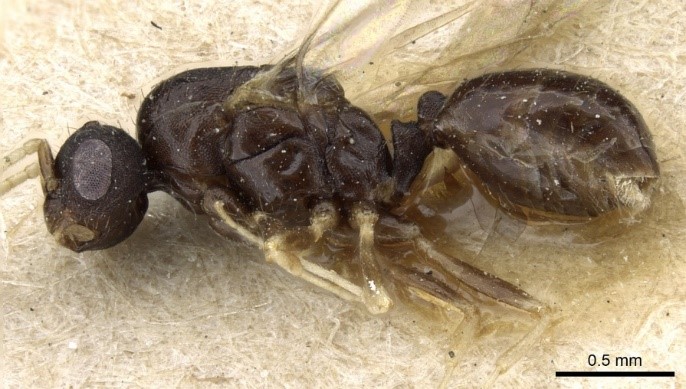 |
| Figure 15. Body of a pharaoh male alate. Photo credits: Zach Lieberman [30] |
3.4. Identification Summary
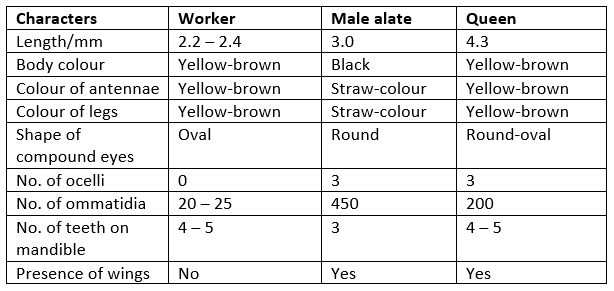 |
| Table 1. Summary of the morphological characters of a pharaoh worker ant, male alate and queen |
 |
| Figure 16. Difference in size between a worker, male alate and queen alate. Image credits: Sabine Deviche [31] |
4. Biology
4.1. Life Cycle
The life cycle of the pharaoh ant has 4 main life stages – egg, larvae, pupae and adult. The whole life cycle takes 25 to 54 days to complete [32]. Throughout the queen’s lifetime (typically 4 – 12 months), she can lay up to 400 eggs in her nest, with approximately 10 to 12 eggs per batch [33]. The eggs will hatch into larvae after 5 to 6 days. Over the next 22 to 24 days, the larvae will grow and develop. They will go through several instar stages, moulting at the end of each stage. The larvae will then pupate and remain as pupae for 9 to 12 days. The adults that emerge will either be sterile female workers (not able to reproduce), or sexuals (either new queens or male alates). The sexuals will only become sexually mature after another 4 to 5 days [34].
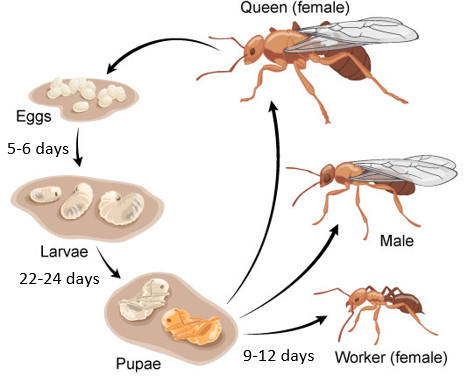 |
| Figure 17. Life cycle of the pharaoh ant. Image credits: Sabine Deviche [35] |
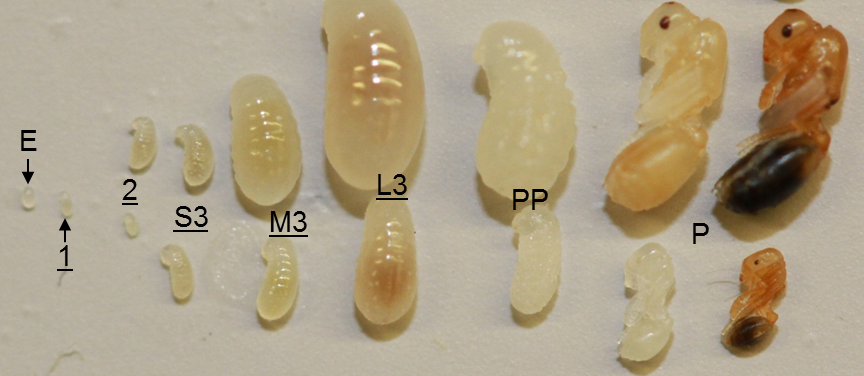 |
| Figure 18. Morphology of the pharaoh ant from egg to adult. Photo credits: Luigi Pontieri [36] |
4.2. Reproduction
Unlike other ant species like Dinomyrmex gigas (giant forest ant), the winged female and male alates of M. pharaonis do not mate during nuptial flights [37]. Colonies of the species are polydomic, meaning that they start off with only one colony but subsequently bud off into multiple colonies [38]. Budding occurs when a queen and her workers leave the nest and start a new colony. Every 3 months to 1 year, the colony will produce new sexuals (males/queens) and this initiates a mating frenzy [39]. Mating episodes last for 15 to 30 minutes every 3 to 4 hours [39]. This occurs throughout the day, with females only mating once while males usually mate multiple times [40]. Young virgin queens will produce a sex pheromone (chemical) to attract and stimulate the males. Despite having wings, the females do not fly and thus mating occurs either within or near the nest [40]. Copulation time is extremely short, lasting 40 to 60 seconds [39].
How do you differentiate a queen that has successfully mated and one that has not? Look at the gaster of the female alate. If the gaster is swollen, it indicates that the female alate has successfully mated. Its physogastric gaster (enlarged abdomen) is swollen with eggs and food reserves and the queen is all ready to lay its first brood of eggs [16]. Once the first generation of worker ants have emerged from the eggs, the pharaoh ant queen can now lead a laidback lifestyle. They are cared for and fed by workers and they have only one job – lay eggs. The workers are in charge of rearing the eggs and these eggs will produce more female workers. Soon, the queen will be tended to by multiple generations of worker ants.
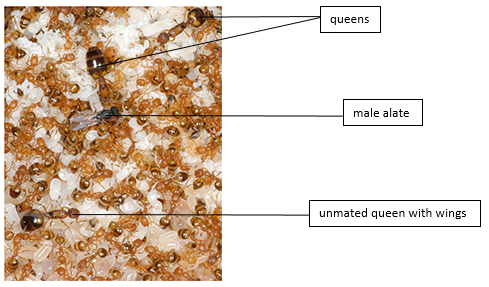 |
| Figure 19. Colony of pharaoh ants. One male alate, three queens and multiple workers tending to a brood of eggs. Photo credits: Elva Robinson [41] |
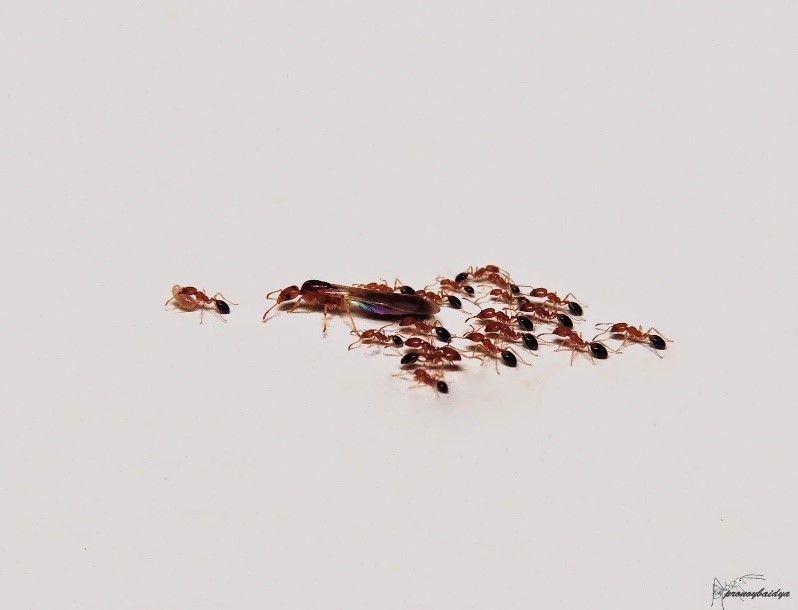 |
| Figure 20. Colony budding. Group of workers following a young queen. Photo credits: Pronoy Baidya [42] |
4.3. Diet
The vast diet of pharaoh ants reflects their tolerance of different habitats. They scavenge on dead insects, most human food and water droplets [43]. Despite being omnivores, they prefer raw and cooked meats, and sweet food [13]. Due to its pest status, various studies have been conducted to investigate which baits (food types) are most effective at attracting pharaoh ants. The baits will then be mixed with toxic chemicals as a pest control measure. It was found that pharaoh ants tend to alternate between protein-rich and carbohydrate-rich foods to ensure a balanced diet [44]. Hence, the most effective bait would be a mixture of both food types. An interesting finding was that honey and peanut butter were particularly attractive to the ants [44]. Don’t we all love sweet and savoury food!
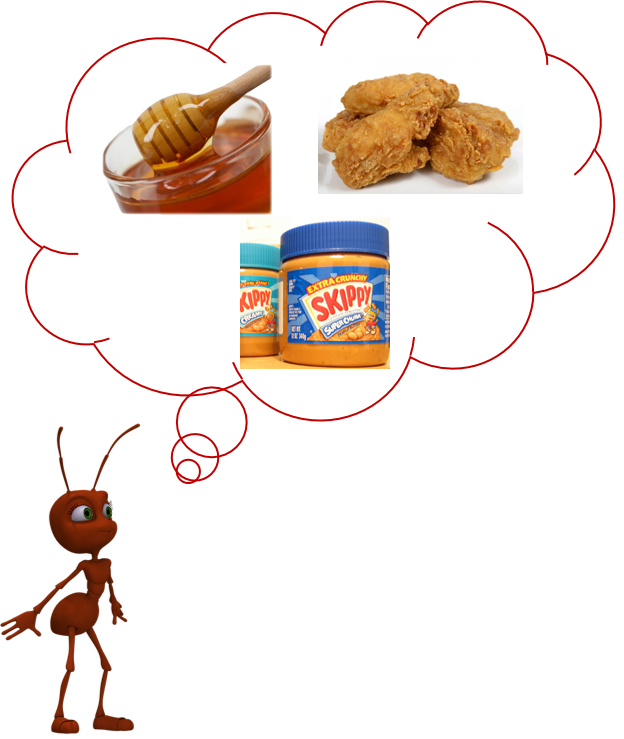 |
| Figure 21. Food that pharaoh ants like to eat. Image credits: Adapted from various sources [45,46,47,48] |
4.4. Foraging
The well-known adage says, “The early bird catches the worm.” In this case, it would be “The early ant forages the food!” The small group of pharaoh scouts are early risers, actively foraging from 7 am to 9 am [43]. Since we see ants everywhere, it seems like they are looking for food randomly. However contrary to expectations, pharaoh ants do not search for food haphazardly. In fact, they conduct an organised food search daily. Each scout has its own specific route for foraging and they follow these routes closely, only diverging every once in a while. However, if food is found outside of a route, a new route from the new food source to the nest would be formed. Over time, the foraging route system will slowly adapt to changes in food distribution, thereby ensuring efficient foraging [43].
You many wonder how do the ant scouts remember their routes. Do they have excellent memory? This is not the case as the scouts mark the routes with pheromones (chemicals), allowing them and foraging workers to follow these routes repeatedly [49]. Upon finding food, the scout will feed before returning back to the nest to recruit workers. However, scouts do not solely rely on the chemical cues to find their way back to the nest. Instead, they also can rely on distant visual stimuli to guide themselves back to the nest [43].
Back at the nest, the scouts will recruit workers for foraging. Recruitment is progressive [43]. The fed workers that have returned will arouse more workers to head out for foraging, thereby increasing recruitment of workers to the food source. As the gasters of fed ants hang down, this leads to a new scent laid on the trail [43, 50]. Subsequent batches of workers can then follow this new scent to the food source. In addition, the recruitment of pharaoh ants is extremely efficient. In less than half an hour, an immense number of workers can be observed feeding on the food. They can even number up to several hundred! Recruits are however not told how far away the food source is from the nest and what type of food it is. Imagine being asked to join your sister for lunch, but not being told how far away the restaurant is and what food you are going to eat!
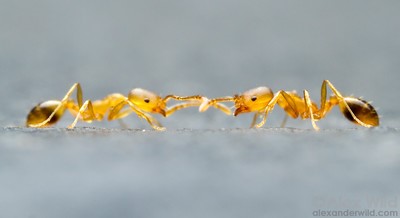 |
| Figure 22. Workers communicating with each other. Photo credits: Alex Wild; Permission pending [51] |
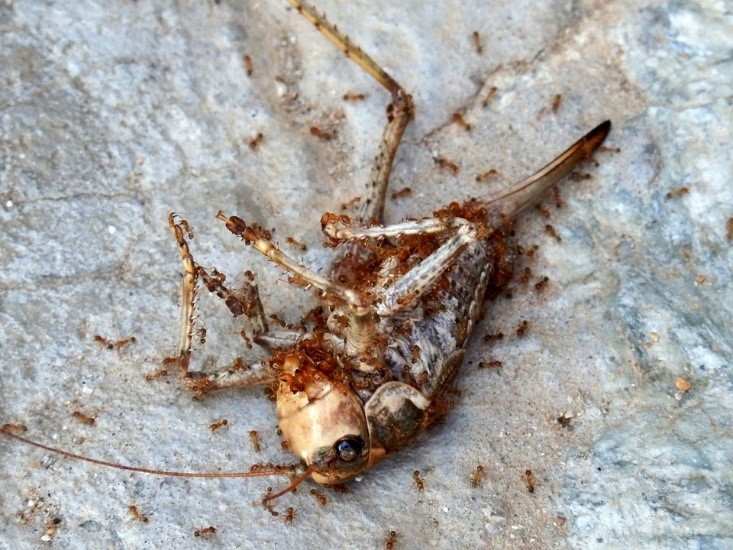 |
| Figure 23. Workers scavenging on a dead cricket. Photo credits: freegr [52] |
4.5. Eusociality
As eusocial insects, pharaoh ants display the 3 main features of eusociality – reproductive division of labour, overlap of generations within a colony, and cooperative brood care [29].
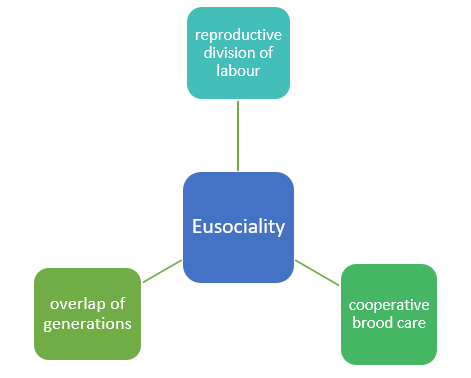 |
| Figure 24. The 3 features of eusociality |
Reproductive division of labour
Each pharaoh ant colony consists of multiple queens [38]. (Not all ant species have multiple queens!) These queens specialize in laying eggs and they are cared for and fed by female worker ants. These workers are sterile; they do not reproduce at all. Instead, they ensure proper functioning of the whole colony – rearing of the eggs, defending against predators and foraging for food [53]. Hence, both the queens and their workers play separate distinct roles from each other in the colony.
Video 1. The queen in her chamber, surrounded by workers tending to her eggs [54]
Overlap of generations
At any point of time, there will be several generations of ants within a colony. The older generations of workers will assist the queens in caring for the younger generations of offspring [55].
Cooperative brood care
The different generations of worker ants cooperate and work together to take care and rear each successive brood of eggs into adults.
Video 2. Workers taking care of the eggs [56]
Video 3. Workers assisting in the birth of a worker [57]
5. Ecology
5.1. Symbiotic Relationships
Mutualism with aphids
Aphids excrete “honeydew”, which attracts various species of ants, including Monomorium pharaonis. Both parties of the relationship benefit – the ants feed on the “honeydew” and the aphids are protected by the ants from their natural enemies [58]. The natural enemies of the aphids include predators and parasitoids. What is the difference between predators and parasitoids? Predators will capture and eat the aphids (e.g. ladybirds), while parasitoids have young that develop on or within the aphids, ultimately killing them (e.g. wasps).
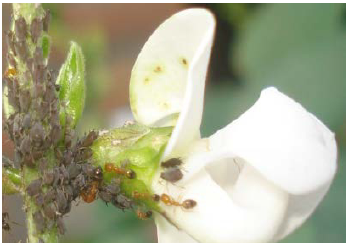 |
| Figure 25. Monomorium pharaonis workers protecting a group of aphids. Photo credits: Ahmad R. M. E. [59] |
Parasitism or not?
Entomopathogenic fungi are parasitesthat infect and kill insects [60]. How does a sessile organism kill a mobile organism? Fungi reproduce through spores, which are dispersed throughout the environment. When a spore lands on its insect host, it will attach and germinate. The fungus will invade the insect body and absorb nutrients to grow. Approximately 3 to 7 days after germination, the insect will starve to death [60]. One such entomopathogenic fungi is Metarhizium brunneum, which infects the pharaoh ant. As M. brunneum is capable of killing the species, pharaoh ants should be running as far away as possible from the fungi. Yet, this is not the case at all. Instead, pharaoh ants were found to favour nests that have been infected with M. brunneum! A possible explanation for this is that exposure to M. brunneum in the infected nests could potentially increase the ants’ immunity, thereby reducing their likelihood of being infected by the fungi [61].
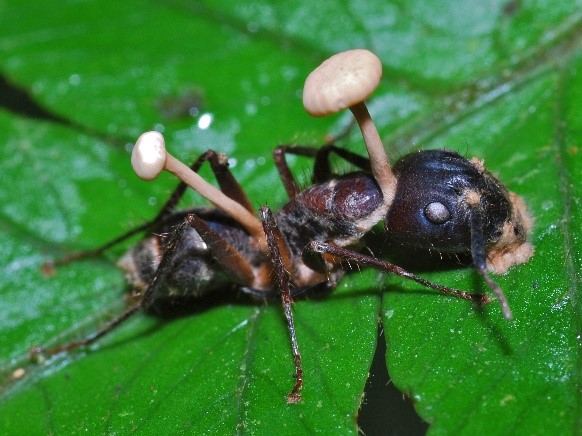 |
| Figure 26. Example of an ant killed by entomopathogenic fungi. Photo credits: Bernard Dupont [62] |
5.2. Human Pathogen Vector
As a tropical species, the pharaoh ant can only survive in the temperate zone in buildings with artificial heating [13]. Hence, they have been known to infest hospitals in the temperate zone. Studies have found the species to be a potential human pathogen vector due to its behaviour. Worker ants have been observed to feed on discharge from patients’ lesions, get into medical equipment and sterile packs, and even bite babies [13]! As the ants carry many pathogens, such as Salmonella, Pseudomonas, Staphylococcus, Streptococcus, Klebsiella and Clostridium spp., they could infect patients with the pathogens they carry [63]. Isolated pharaoh ants have even been found to carry antimicrobial-resistant bacteria [64]! This is a cause of worry as the ants could potentially increase infection rates in hospitals. They pose a serious health threat to hospitals and thus it is prevalent for measures to be taken to eliminate the species from infested hospitals.
 |
| Figure 27. IV drip and sterile packs that pharaoh ants have been observed to get into. Image credits: Adapted from various sources [65,66] |
6. Taxonomy and Systematics
6.1. Original Description
Monomorium pharaonis was first described by Carl Linnaeus as Formica pharaonis in “Systema Naturæ” or “Systema Naturae” in 1758 [67]. Linnaeus described the species based on a specimen from Egypt, describing it as having a “more brown abdomen”.
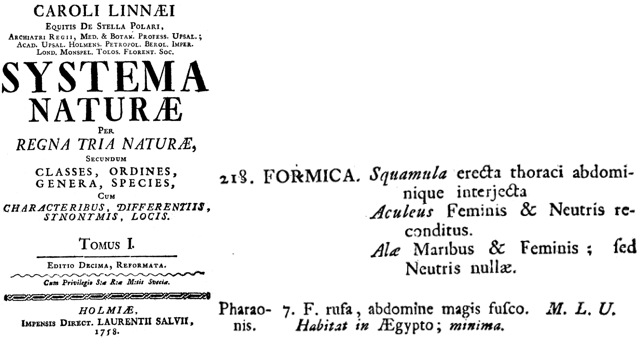 |
| Figure 28. Original description of Formica pharaonis in “Systema Naturæ” or Systema Naturae in 1758. Image credits: Carl Linnaeus [67] |
6.2. Type Information
Holotype specimen of subspecies
The holotype of Myrmica contigua Smith 1858 (subspecies of Monomorium pharaonis) is currently located in the Natural History Museum, London. It consists of specimens of two dealate queens that were collected in Sri Lanka on November 30, 1999 [68,69]. Subspecies of M. pharaonis have type specimens in case the subspecies is later elevated to species level.
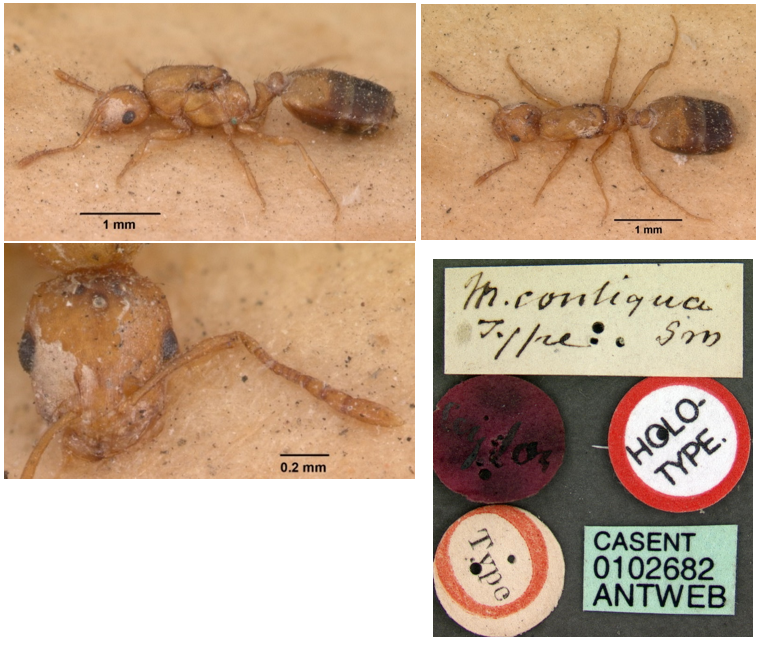 |
| Figure 29. Holotype of Myrmica contigua, now known as Monomorium pharaonis. Photo credits: April Nobile [70] |
Type specimen of subspecies from Singapore
The pharaoh ant is not native to Singapore [71]. The first published record of M. pharaonis in Singapore was in 1858, under the name of Myrmica vastator [5]. The specimen is a lectotype. This means that it was later selected from a set of syntypes to become the single type specimen for the species.
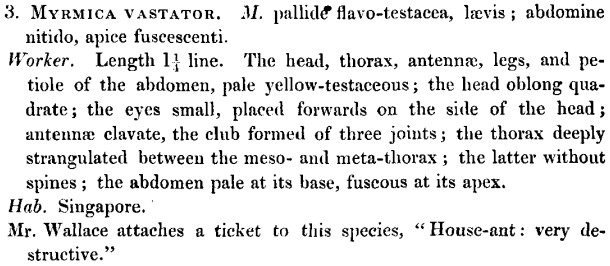 |
| Figure 30. First published record of Monomorium pharaonis in Singapore, previously known as Mymica vastator. Image credits: Gustav Mayr [72] |
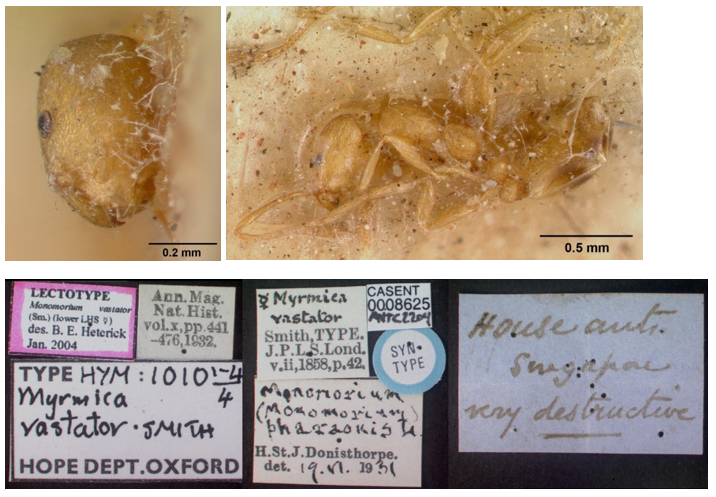 |
| Figure 31. Lectotype of Monomorium vastator from Singapore. Photo credits: April Nobile [73] |
6.3. Common Names
Pharaoh ant / Sugar ant / Tramp ant
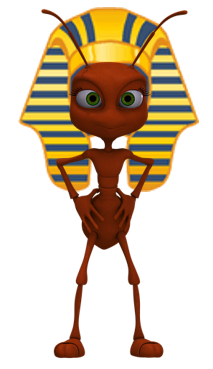 |
| Figure 32. Pharaoh ant. Image credits: Adapted from various sources [74,75] |
6.4. Etymology
Why is Momomorium pharaonis called the pharaoh ant? There are two hypotheses. One hypothesis is that the species was first described using type specimens from Egypt [5,12]. The other hypothesis is that Linnaeus mistook the species to be responsible for one of the biblical plagues in Egypt during the reigns of pharaohs [76]. It is interesting to note that among the 10 biblical plagues of Egypt, 3 of them involved insects: lice, flies and locusts. However, the Bible did not mention any plagues involving ants. Perhaps, the pharaoh ant was such a widespread pest in Egypt at that time that the Egyptians considered it a plague!
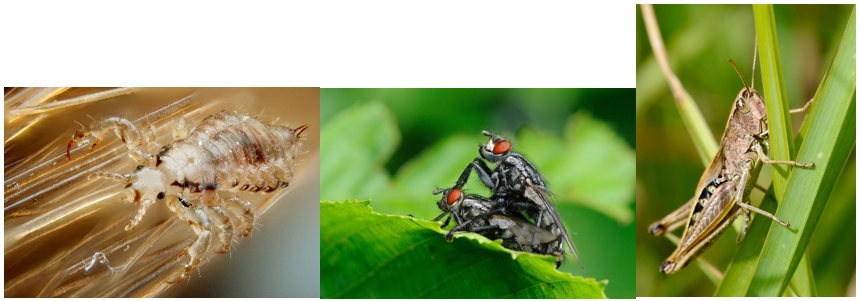 |
| Figure 33. The 3 insect groups responsible for the biblical plagues in Egypt. Image credits: Adapted from various sources [77,78,79] |
6.5. Scientific Name and Synonyms
Scientific Name: Monomorium pharaonis (Linnaeus, 1758)
Originally described by Linnaeus in 1758 as Formica pharaonis, the pharaoh ant has since been reclassified and renamed multiple times by numerous authors internationally. Initially placed in the Formica genus, Gustav Mayr, an Austrian entomologist, reclassified the species under Monomorium genus [72].
 |
| Figure 34. Mayr’s published record of reclassifying the pharaoh ant into the Monomorium genus. Image credits: Gustav Mayr [80] |
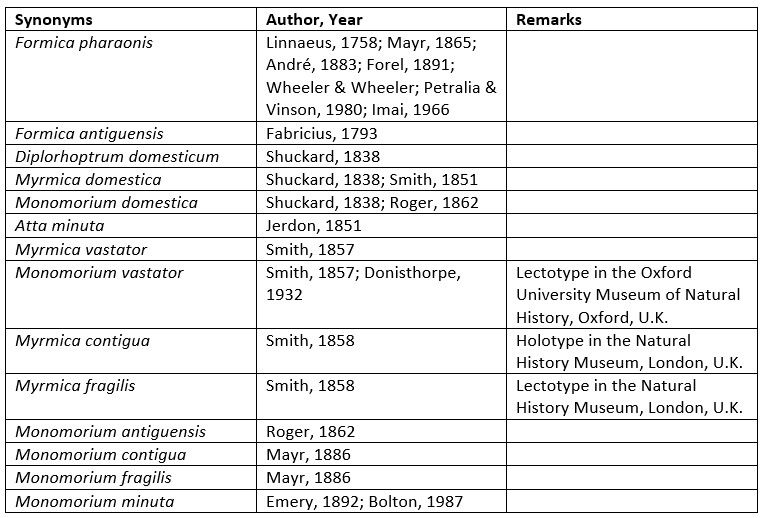 |
| Table 2. Table of Monomorium pharaonis synonyms [68,81,82,83,84,85] |
6.6. Taxonomic Hierarchy
Kingdom: Animalia
Phylum: Arthropoda
Class: Insecta
Order: Hymenoptera
Superfamily: Vespoidea
Family: Formicidae
Subfamily: Myrmicinae
Tribe: Solenopsidini
Genus: Monomorium
Species: Monomorium pharaonis
7. Phylogeny
Position of the Solenopsidini tribe within subfamily Myrmicinae
Monomorium pharaonis can be observed within the Solenopsidini tribe, in a subsection of the phylogenetic tree for subfamily Mymicinae (Fig. 35). The phylogenetic tree was produced through partitioned Maximum Likelihood (ML) analysis and partitioned MrBayes analysis of a concatenated 11-gene dataset. The 11 genes used in the analysis include two ribosomal genes (18S rDNA and 28S rDNA) and nine protein-coding genes (abdominal-A (Abd-A), elongation factor 1-alpha F1 copy (EF1aF1), elongation factor 1-alpha F2 copy (EF1aF2), long wavelength rhodopsin (LW Rh), arginine kinase (ArgK), topoisomerase 1 (Top1), ultrabithorax (Ubx), wingless (Wg) and rudimentary (CAD)). 17 outgroup taxa were used. They include other ant subfamilies and an aculeate hymenopteran wasp that was used to root the tree [86].
The broad phylogenetic relationships within subfamily Myrmicinae are stable and strongly supported across multiple methods of phylogenetic inference. The entire phylogenetic tree was not affected by alternate Bayesian analyses, exclusion of several base frequency heterogeneous positions etc. Each node of the phylogenetic tree has two support values: the Bayesian posterior probability (PP) and ML bootstrap percentage (BS). The Solenopsidini tribe has a high degree of support with PP value of 1.00 and BS value of 99 (Fig. 35). Results show that the Monomorium genus is not monophyletic. Some species of the genus belong top the Solenopsidini tribe, while three other species belong to the Crematogastrini tribe [86].
 |
| Table 3. Degree of support for different support values |
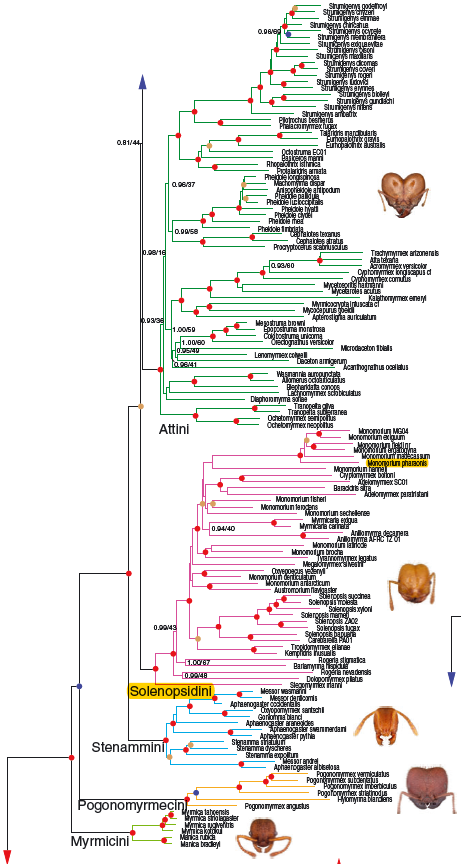 |
| Figure 35. Subset of phylogenetic tree of subfamily Myrmicinae that shows the position of Monomorium pharaonis in tribe Solenopsidini. Image credits: Ward et al. [87] |
Position of Monomorium genus in the evolution of thorax architecture
The thorax thorax morphology of queens and workers in species from 21 of the 25 ant subfamilies (extinct and extant) were analysed using a phylogenetically broad comparative approach to investigate external morphology and internal anatomy in the context of caste-specific specialized behaviors. Parsimony and ML methods were used to reconstruct ancestral character states. The Monomorium genus was found most closely related to the Leptothorax genus [88]. Species in the Monomorium genus have reduced first thoracic segments (T1).
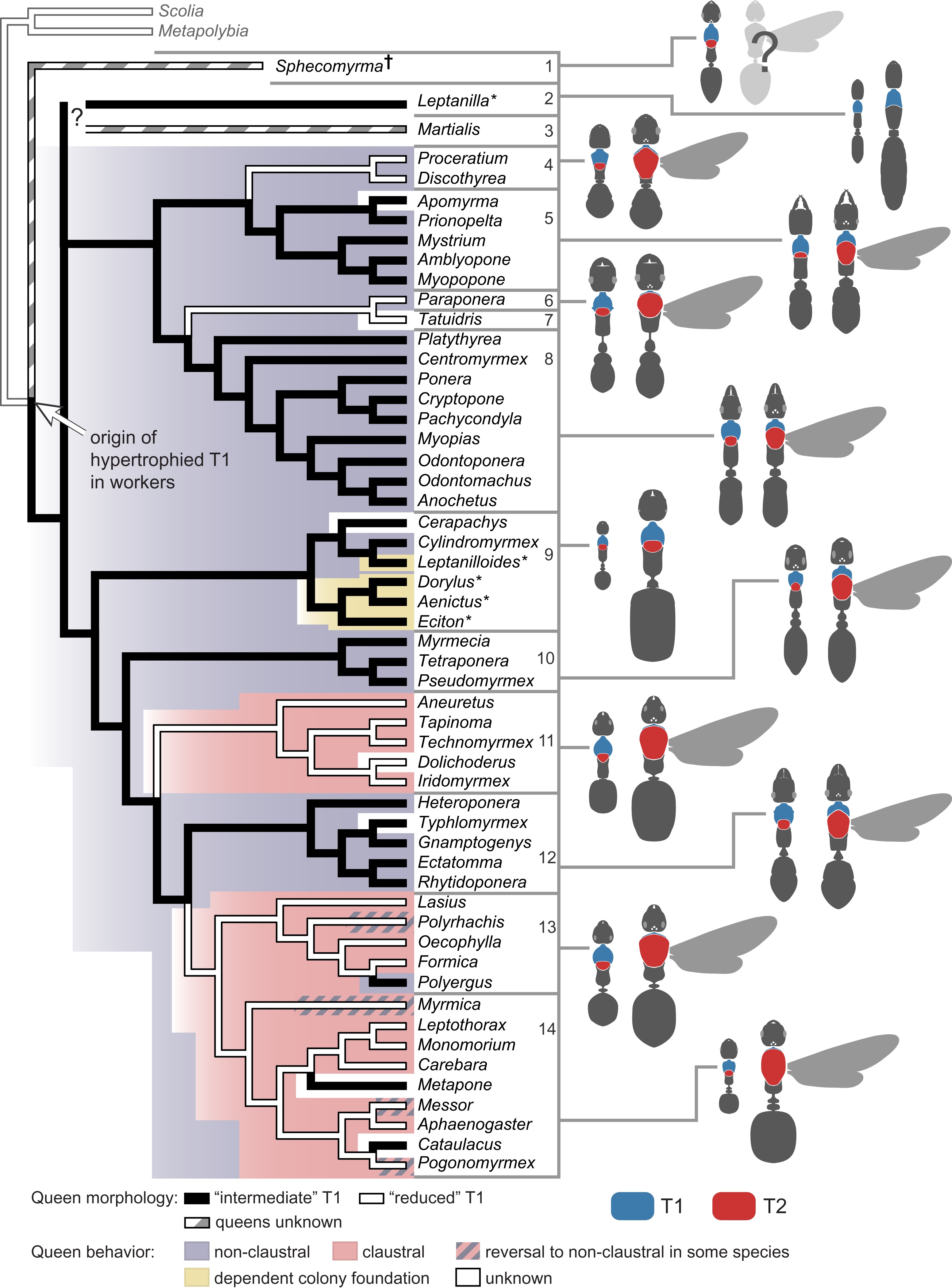 |
| Figure 36. Phylogenetic tree that shows the position of Monomorium genus in the evolution of thorax architecture. Image credits: Keller et al. [88] |
Position of Monomorium pharaonis in the evolution of reproductive division of labour
The phylogenetic analysis was partitioned by gene and conducted under a GTRGAMMA model. A dataset of 1427 genes and 3.59 Mb of sequence was used to analyse the phylogenetic relationships of 16 ant species, including M. pharaonis, and three biological traits: worker sterility, colony queen number and invasiveness. The phylogenetic tree was constructed using OGG alignments with the software RAxML (v. 8). Among the 16 ant species, M. pharaonis was found most closely related to M. chinense [89]. Pharaoh ant workers are completely sterile. In addition, there are multiple queens in a colony and the species is potentially invasive.
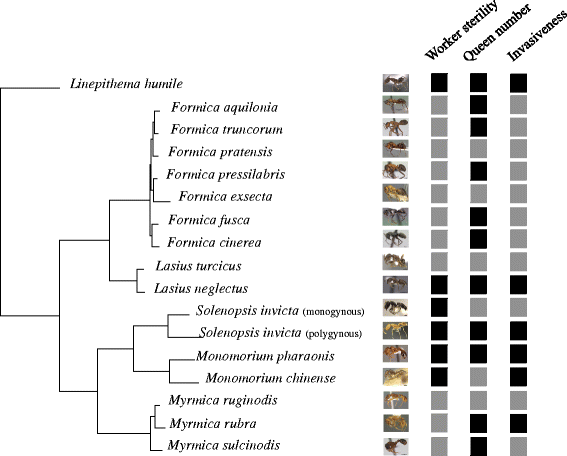 |
| Figure 37. Phylogenetic tree that shows the position of Monomorium pharaonis in the evolution of reproductive division of labour. Image credits: Morandin et al. [89] |
8. References
[1] “Pharaoh ant Monomorium pharaonis queen and workers”, by Luigi Pontieri. Linksvayer Lab, September 2016. URL: https://web.sas.upenn.edu/linksvayer-lab/research/the-pharaoh-ant-monomorium-pharaonis/ (accessed on 29 Oct 2017).
[2] Billen, J. (E.d.), 1992. Biology and Evolution of Social insects. Leuven. Belgium: Leuven University Press.
[3] Fowler, H. G., Anaruma Filho, F. & Bueno, O. C., 1993. Seasonal space usage by the introduced pharaoh's ant, Monomorium pharaonis (L.) (Hym., Formicidae), in institutional settings in Brazil and its relation to other structural ant species. Journal of Applied Entomology, 115: 416–419.
[4] McGlynn, T. P., 1999. The worldwide transfer of ants: geographical distribution and ecological invasions. Journal of Biogeography, 26, 535–548.
[5] Wetterer, J. K., 2010. Worldwide spread of the pharaoh ant, Monomorium pharaonis (Hymenoptera: Formicidae). Myrmecological News, 13: 115 –129.
[6] “Pharaoh insignia”, by Jeff Dahl. Wikimedia Commons, 7 February 2016. URL: https://commons.wikimedia.org/wiki/File:Pharaoh-insignia.png (accessed on 29 Oct 2017).
[7] “Profile view of ant Monomorium pharaonis specimen casent0173986”, by April Nobile. Wikimedia Commons, 11 March 2008. URL: https://commons.wikimedia.org/wiki/File:Monomorium_pharaonis_casent0173986_profile_1.jpg (accessed on 29 Oct 2017).
[8] “Ant icon from The Noun Project”, by Jacob Eckert. Wikimedia Commons, 2012. URL: https://commons.wikimedia.org/wiki/File:Ant_(Jacob_Eckert).svg (accessed on 29 Oct 2017).
[9] "Compared size of a pharaoh ant", by J-E Nystrom. Wikimedia Commons, 30 June 2009. URL: https://commons.wikimedia.org/wiki/File:Monomorium_pharaonis.jpg (accessed on 3 Dec 2017).
[10] “Monomorium pharaonis pharaoh ant”, by Daniel Morris. Animal Diversity Web, 2000. URL: http://animaldiversity.org/accounts/Monomorium_pharaonis/ (accessed on 1 Nov 2017).
[11] Ossian, H. L., 1901. The insect book. New York: Doubleday, Page & Company.
[12] McGlynn, T. P., 1999. The worldwide transfer of ants: geographical distribution and ecological invasions. Journal of Biogeography, 26, 535–548.
[13] Beatson, S. H., 1972. Pharaoh’s ants as pathogen vectors in hospitals. The Lancet, 299(7747): 425–427.
[14] Lee, C., 2002. Tropical household ants: pest status, species diversity, foraging behavior, and baiting studies. Proceedings of the 4th International Conference on Urban Pests: 3–18.
[15] “Monomorium pharaonis (insect)”, by IUCN SSC Invasive Species Specialist Group. Global Invasive Species Database, 4 October 2010. URL: http://issg.org/database/species/ecology.asp?si=961&fr=1&sts=&lang=EN (accessed on 1 Nov 2017).
[16] Wilson, E. O., 1971. The Insect Societies. Cambridge. Massachusetts: Belknap Press of Harvard University Press.
[17] “The flowers on the grassland with flowers in Badlands National Park, South Dakota”. Goodfreephotos. URL: https://www.goodfreephotos.com/united-states/south-dakota/badlands-national-park/south-dakota-badlands-national-park-yellow-flowers-on-the-grassland.jpg.php (accessed on 11 Dec 2017).
[18] “Jackass Mountain in the Fraser Canyon area”, by Jerrye & Roy Klotz, MD. Wikipedia Commons, 20 September 2008. URL: https://commons.wikimedia.org/wiki/File:JACKASS_MOUNTAIN,_BRITISH_COLUMBIA.jpg (accessed on 11 Dec 2017).
[19] “Straw bales”, by bogitw. pixabay, 23 July 2013. URL: https://pixabay.com/p-726976/?no_redirect (accessed on 11 Dec 2017).
[20] “View of Shinjuku skyscrapers and Mount Fuji as seen from the Bunkyo Civic Center, Bunkyo Ward, Tokyo”, by Morio. Wikipedia Commons, 25 January 2009. URL: https://commons.wikimedia.org/wiki/File:Skyscrapers_of_Shinjuku_2009_January_(revised).jpg (accessed on 11 Dec 2017).
[22] “Pharaoh ants, Monomorium pharaonis (Linnaeus), in an electrical switch mechanism”, by Jim Kalisch. Featured Creatures, June 2003. URL: http://entnemdept.ufl.edu/creatures/urban/ants/pharaoh_ant.htm (accessed on 29 Oct 2017)
[23] Viehmeyer, H., 1906: Beiträge zur Ameisenfauna des Königreiches Sachsen. Abhandlungen der Naturwissenschaftlichen Gesellschaft ISIS in Dresden, 1906: 55–69.
[24] Wilson, E. O., 1968. The ants of Polynesia (Hymenoptera: Formicidae). Pacific Insects, 14: 1–109.
[25] Wetterer, J. K., Walsh, P. D. & White, L. J. T., 1999. Wasmannia auropunctata (Roger) (Hymenoptera: Formicidae), a destructive tramp-ant, in wildlife refuges of Gabon. African Entomology, 7(2): 1–3.
[26] “Worldwide distribution records of Monomorium pharaonis”, by Wetterer J. K. ResearchGate, April 2010. URL: https://www.researchgate.net/figure/256979599_fig1_Fig-5-Worldwide-distribution-records-of-Monomorium-pharaonis-R-Sullivan-Rhode (accessed on 29 Oct 2017).
[27] “Plate 1. Monomorium pharaonis male (left), queen (centre) and worker (right)”, by Edwards J. P. & Baker L. F. ScienceDirect, 1981. URL: http://www.sciencedirect.com/science/article/pii/0195670181900451 (accessed on 29 Oct 2017)
[28] Hall, D. W., 1951. Studies in Pharaoh's ant, Monomorium pharaonis (L.). (6) External characters, size variation and cephalic ratios. Entomologists Monthly Magazine, 87: 217 –221.
[29] Aktaç N. & Kiran K., 2006. A new household ant record for Turkish Thrace [Monomorium pharaonis (L.)] (Hymenoptera, Formicidae). Linzer Biologische Beiträge, 38(2): 1123 –1128.
[30] Jackson, D. E. & Ratnieks, F. L. W., 2006. Communication in ants. Current Biology, 15(8): R570 –R574.
[31] Na, J. P. S. & Lee C. Y., 2001. Identification key to common urban pest ants in Malaysia. Tropical Biomedicine, 18(1): 1 –17.
[32] “Specimen: CASENT0104095 Monomorium pharaonis”, by April Nobile. AntWeb, 14 December 2007. URL: https://www.antweb.org/bigPicture.do?name=casent0104095&shot=h&number=1 (accessed on 29 Oct 2017).
[33] “Specimen: CASENT0104095 Monomorium pharaonis”, by April Nobile. AntWeb, 14 December 2007. URL: https://www.antweb.org/bigPicture.do?name=casent0104095&shot=p&number=1 (accessed on 29 Oct 2017).
[34] “Specimen: CASENT0147465 Trichomyrmex destructor”, by Erin Prado. AntWeb, 11 March 2011. URL: https://www.antweb.org/bigPicture.do?name=casent0147465&shot=p&number=1 (accessed on 29 Oct 2017).
[35] “Specimen: CASENT0104094 Monomorium pharaonis”, by April Nobile. AntWeb, 14 February 2005. URL: https://www.antweb.org/bigPicture.do?name=casent0104094&shot=h&number=1 (accessed on 29 Oct 2017).
[36] “Specimen: CASENT0104094 Monomorium pharaonis”, by April Nobile. AntWeb, 14 February 2005. URL: https://www.antweb.org/bigPicture.do?name=casent0104094&shot=p&number=1 (accessed on 29 Oct 2017).
[37] “Monomorium pharaonis (Linnaeus 1758). Worker: (a) Head (Frontal view), (b) Thorax, petiole, postpetiole (in profile); queen: (c) Head (Frontal view), (d) Thorax, petiole, postpetiole (in profile)”, by Nihat Aktaç & Kadri Kiran. Biologiezentrum Linz, 29 December 2006. URL: http://www.zobodat.at/pdf/LBB_0038_2_1123-1128.pdf (accessed on 29 Oct 2017).
[38] “Pharaoh's Ants”, by Lewisham Council. Pest control. URL: https://www.lewisham.gov.uk/myservices/environment/pestcontrol/Documents/PharoahsAntsInformationSheet.pdf (accessed on 1 Nov 2017).
[29] “Specimen: CASENT0904634 Monomorium pharaonis”, by Zach Lieberman. AntWeb, 10 May 2013. URL: https://www.antweb.org/bigPicture.do?name=casent0904634&shot=h&number=1 (accessed on 29 Oct 2017).
[30] “Specimen: CASENT0904634 Monomorium pharaonis”, by Zach Lieberman. AntWeb, 10 May 2013. URL: https://www.antweb.org/bigPicture.do?name=casent0904634&shot=p&number=1 (accessed on 29 Oct 2017).
[31] “Assorted ant graphics”, by Sabine Deviche. Ask A Biologist. URL: http://devichedesigns.com/work/ants (accessed on 29 Oct 2017).
[32] Alvares, L. E., Bueno, C. & Fowler, H. G., 1993. Larval instars and immature development of a Brazilian population of pharaoh’s ant, Monomorium pharaonis (L.) (Hym., Formicidae). Journal of Applied Entomology, 116: 90–93.
[33] “Monomorium pharaonis (pharaoh ant)”, by Centre for Agriculture and Bioscience International. Invasive Species Compendium, 27 July 2017. URL: https://www.cabi.org/isc/datasheet/34587 (accessed on 1 Nov 2017).
[34] “Monomorium pharaonis pharaoh ant”, by Daniel Morris. Animal Diversity Web, 2000. URL: http://animaldiversity.org/accounts/Monomorium_pharaonis/ (accessed on 1 Nov 2017).
[35] “The life cycle of ants”, by Sabine Deviche. Ask A Biologist. URL: http://devichedesigns.com/work/ants (accessed on 29 Oct 2017).
[36] “Reproductive caste is readily determined by the 2nd instar: queens top row, workers bottom row. Female development is shown across the following stages: egg (E); 1st instar (1); 2nd instar (2); sm.all, medium, and large 3rd instar (S3,M3,L3); prepupae (PP); and pupae (P)”, by Luigi Pontieri. Linksvayer Lab. URL: https://web.sas.upenn.edu/linksvayer-lab/research/the-pharaoh-ant-monomorium-pharaonis/ (accessed on 29 Oct 2017).
[37] Passera, L. & Keller, L., 1990. Loss of mating flight and shift in the pattern of carbohydrate storage in sexuals of ants (Hymenoptera; Formicidae). Journal of Comparative Physiology B, 160: 207–211.
[38] Edwards, J. P., 1987. Caste regulation in the pharaoh’s ant Monomorium pharaonis: the influence of queens on the production of new sexual forms. Physiological Entomology, 12: 31–39.
[39] Allard, D., Børgesen, Van Hulle, M., Bobbaers, A., Billen, J. & Gobin, B., 2006. Sperm transfer during mating in the pharaoh’s ant, Monomorium pharaonis. Physiological Entomology, 31(3): 294–298.
[40] Fowler, H. G., Alves, L. E. & Bueno, O. C., 1993. Reproductive strategies of the exotic Pharaoh's ant, Monomorium pharaonis (L.) (Hymenoptera: Formicidae) in Brazil. Invertebrate Reproduction and Devel.opment, 23(2): 235–238.
[41] “Ant nest”, by Elva Robinson. University of York, 2010. URL: https://www.york.ac.uk/biology/research/ecology-evolution/elva-robinson/ (accessed on 29 Oct 2017).
[42] “Monomorium pharaonis (Linnaeus, 1758) "daughter" queen accompanied by worker sisters. Note the difference in the size of queen and workers”, by Pronoy Baidya. Ant Trail – My Journey with Ants. URL: http://myjourneywithants.blogspot.sg/2014/12/ (accessed on 29 Oct 2017).
[43] Sudd, J. H., 1960. The foraging method of Pharaoh's ant, Monomorium pharaonis (L.). Animal Behaviour, 8(1–2): 67–75.
[44] Edwards, J. P. & Abraham, L., 1990. Changes in food selection by workers of the pharaoh’s ant, Monomorium pharaonis. Medical and Veterinary Entomology, 4: 205–211.
[45] “Two jars of Skippy peanut butter purchased in Greece”, by Pinikas. Wikipedia, 2 June 2006. URL: https://en.wikipedia.org/wiki/File:Skippy_jars.jpg (accessed on 29 Oct 2017).
[46] “Honey in a glass, with a honey dipper”, by Lama Raheem. Wikimedia Commons, 19 November 2015. URL: https://commons.wikimedia.org/wiki/File:Honey-benefits.jpg (accessed on 29 Oct 2017).
[47] “Crispy chicken”. pxhere, 23 February 2017. URL: https://pxhere.com/en/photo/819605 (accessed on 29 Oct 2017).
[48] “Red ant”, by susannp4. pixabay, 18 December 2015. URL: https://pixabay.com/p-1096392/?no_redirect (accessed on 29 Oct 2017).
[49] Jackson, D. E., Martin, S. J., Holcombe, M. & Ratnieks, F. L. W., 2006. Longevity and detection of persistent foraging trails in Pharaoh's ants, Monomorium pharaonis (L.). Animal Behaviour, 71(2): 351–359.
[50] Billen, J. (E.d.), 1992. Biology and Evolution of Social insects. Leuven. Belgium: Leuven University Press.
[51] “Friend or foe? Two Monomorium pharaonis worker ants briefly touch antennae along a pheromone trail. Icononzo, Tolima, Colombia”, by Alex Wild. Alex Wild The Diversity of Insects. URL: http://www.alexanderwild.com/Ants/Taxonomic-List-of-Ant-Genera/Monomorium/i-nTVVnKQ/A (accessed on 29 Oct 2017).
[52] “Dead insect”, by freegr. pixabay, 14 August 2013. URL: https://pixabay.com/p-172536/?no_redirect (accessed on 29 Oct 2017).
[53] Cahan, S. H. & Gardner-Morse, E., 2013. The emergence of reproductive division of labor in forced queen groups of the ant Pogonomyrmex barbatus. Journal of Zoology, 291(1): 12–22.
[54] "Monomorium pharaonis pharaoh ant queen egg chamber", by Microcity. Youtube, 19 March 2014. URL: https://www.youtube.com/watch?v=Q240M_VqOxY
[55] “Eusocial Insects”, by Rice University. Bios321. URL: http://es.rice.edu/projects/Bios321/eusocial.insect.html (accessed on 1 Nov 2017).
[56] “Monomorium pharaonis pharaoh ant brood cleaning and feeding by repletes caste”, by Microcity. Youtube, 19 March 2014. URL: https://www.youtube.com/watch?v=LxxPreENN24 (accessed on 29 Oct 2017).
[57] "Monomorium pharaonis worker birth", by Microcity. Youtube, 19 March 2014. URL: https://www.youtube.com/watch?v=4c9IV4y2o6U (accessed on 3 Dec 2017).
[58] Rakhshan, M. E. A., 2015. Study of mutualistic ants associated with Aphis craccivora (Hemiptera: Aphididae) on various host plants of family Fabaceae in Northeast Bihar (India). European Scientific Journal, 11(18): 1857–7881.
[59] “Plate-8: M. pharaonis”, by Ahmad R. M. E. European Scientific Journal, June 2015. URL: https://eujournal.org/index.php/esj/article/view/5842/5657 (accessed on 29 Oct 2017).
[60] Shah, P. A. & Pell, J. K., 2003. Entomopathogenic fungi as biological control agents. Applied Microbiology and Biotechnology, 61: 413–423.
[61] Pontieri, L., Vojvodic, S., Graham, R., Pedersen, J. S. & LInksvayer, T. A., 2014. Ant Colonies Prefer Infected over Uninfected Nest Sites. PLoS ONE, 9(11): e111961.
[62] “Ant Killed by Fungus - Cockscomb Wildlife Sanctuary, Belize”, by Bernard Dupont. Wikimedia Commons, 14 February 2008. URL: https://commons.wikimedia.org/wiki/File:Ant_Killed_by_Fungus_-_Cockscomb_Wildlife_Sanctuary,_Belize.jpg (accessed on 29 Oct 2017).
[63] Edwards, J. P. & Baker L. F., 1981. Distribution and importance of the Pharaoh's ant Monomorium pharaonis (L) in National Health Service Hospitals in England. Journal of Hospital Infection, 2: 249–254.
[64] MoreiraI, D. D. O., de MoraisI, V., Vieira-da-MottaII, O., Campos-FarinhaIII, A. E. de C. & Tonhasca Jr, A., 2005. Ants as carriers of antibiotic-resistant bacteria in hospitals. Neotropical Entomology, 34(6): 999–1006.
[65] “Infuuszakjes”, by Harmid. Wikimedia Commons. URL: https://commons.wikimedia.org/wiki/File:Infuuszakjes.jpg (accessed on 29 Oct 2017).
[66] “Two packages of gauze”, by James Heilman. Wikimedia Commons, 2 February 2016. URL: https://commons.wikimedia.org/wiki/File:PackagesOfGauze.JPG (accessed on 29 Oct 2017).
[67] “Systema Naturae”, by Carl Linnaeus. Internet Archive, 1758. URL: https://archive.org/details/cbarchive_53979_linnaeus1758systemanaturae1758 (accessed on 29 Oct 2017).
[68] “[node:field-institution-code] - ANTC4953 - CASENT0102682”, by Eli Sarnat. Antkey, 18 October 2012. URL: http://antkey.org/en/content/nodefield-institution-code-antc4953-casent0102682 (accessed on 3 Nov 2017).
[69] “Specimen: CASENT0102682 Monomorium pharaonis”, by California Academy of Sciences. AntWeb. URL: https://www.antweb.org/specimen.do?name=casent0102682 (accessed on 3 Nov 2017).
[70] “Specimen: CASENT0102682 Monomorium pharaonis”, by April Nobile. AntWeb, 14 December 2004. URL: https://www.antweb.org/specimenImages.do?name=casent0102682 (accessed on 29 Oct 2017).
[71] Tan, C. K. W., & Corlett, R. T., 2012. Scavenging of dead invertebrates along an urbanisation gradient in Singapore. Insect Conservation and Diversity, 5(2): 138–145.
[72] “Myrmica” by Gustav Mayr. Die Formiciden der Vereinigten Staaten von Nordamerika, December 1886. URL: https://ia601407.us.archive.org/19/items/ants_04383/4383.pdf (accessed on 29 Oct 2017).
[73] “Specimen: CASENT0008625 Monomorium pharaonis”, by April Nobile. AntWeb, 12 April 2005. URL: https://www.antweb.org/specimenImages.do?name=casent0008625 (accessed on 29 Oct 2017).
[74] "Pharaoh's Helm". Webkinz Insider, 14 June 2013. URL: http://www.webkinzinsider.com/wiki/Gold_Clothing_Collection (accessed on 3 Dec 2017).
[75] "Red Ant", by susannp4. pixabay, 18 December 2015. URL: https://pixabay.com/en/ant-insect-red-ant-funny-cartoon-1096390/ (accessed on 3 Dec 2017).
[76] “Monomorium pharaonis (insect)”, by IUCN SSC Invasive Species Specialist Group. Global Invasive Species Database, 4 October 2010. URL: http://issg.org/database/species/ecology.asp?si=961&fr=1&sts=&lang=EN (accessed on 1 Nov 2017).
[77] “Male human head louse”, by Gilles San Martin. Wikimedia Commons, 17 August 2010. URL: https://commons.wikimedia.org/wiki/File:Male_human_head_louse.jpg (accessed on 29 Oct 2017).
[78] “Insect Macro Flies”. Max Pixel. URL: http://maxpixel.freegreatpicture.com/Insect-Macro-Flies-1817942 (accessed on 29 Oct 2017).
[79] “Desert Locust”, by christels. pixabay, January 2017. URL: https://pixabay.com/p-1973910/?no_redirect (accessed on 29 Oct 2017).
[80] “Formicidae”, by Gustav Mayr. AntWeb, 1865. URL: https://www.antweb.org/description.do?rank=species&genus=monomorium&name=pharaonis&project=worldants (accessed on 29 Oct 2017).
[81] “Species: Monomorium pharaonis”, by California Academy of Sciences. AntWeb. URL: https://www.antweb.org/description.do?genus=monomorium&name=pharaonis&rank=species (accessed on 3 Nov 2017).
[82] “Genus Monomorium Monomorium pharaonis (L.)”, by Brian Taylor. The Ants of Africa. URL: http://antsofafrica.org/ant_species_2012/monomorium/monomorium_pharaonis/monomorium_pharaonis.htm (accessed on 3 Nov 2017).
[83] “Specimen: CASENT0008625 Monomorium pharaonis”, by California Academy of Sciences. AntWeb. URL: https://www.antweb.org/specimen.do?name=casent0008625 (accessed on 3 Nov 2017).
[84] “Species: Monomorium pharaonis”, by California Academy of Sciences. AntWeb. URL: https://www.antweb.org/browse.do?rank=species&genus=monomorium&name=pharaonis&project=worldants (accessed on 3 Nov 2017).
[85] “Specimen: CASENT0102330 Monomorium pharaonis”, by California Academy of Sciences. AntWeb. URL: https://www.antweb.org/specimen.do?name=casent0102330 (accessed on 3 Nov 2017).
[86] Ward, P. S., Brady, S. G., Fisher, B. L. & Schultz, T. R., 2015. The evolution of myrmicine ants: phylogeny and biogeography of a hyperdiverse ant clade (Hymenoptera: Formicidae). Systematic Entomology, 40(1): 61–81.
[87] “Maximum likelihood (ML) phylogeny of the ant subfamily Myrmicinae, including formicoid and poneroid outgroups”, by Ward P. S., Brady S. G., Fisher B. L. & Schultz T. R. Wiley Online Library, 2015. URL: http://onlinelibrary.wiley.com/doi/10.1111/syen.12090/abstract (accessed on 29 Oct 2017).
[88] Morandin, C., Tin, M. M. Y., Abril, S., Gómez, C., Pontieri, L., Schiøtt, M., Sundström, L., Tsuji, K., Pedersen, J. S., Helanterä, H. & MIkheyev, A. S., 2016. Comparative transcriptomics reveals the conserved building blocks involved in parallel evolution of diverse phenotypic traits in ants. Genome Biology, 17(43).
[89] Keller, R. A., Peeters, C. & Beldade, P., 2014. Evolution of thorax architecture in ant castes highlights trade-off between flight and ground behaviors. eLife 2014(3): e01539.